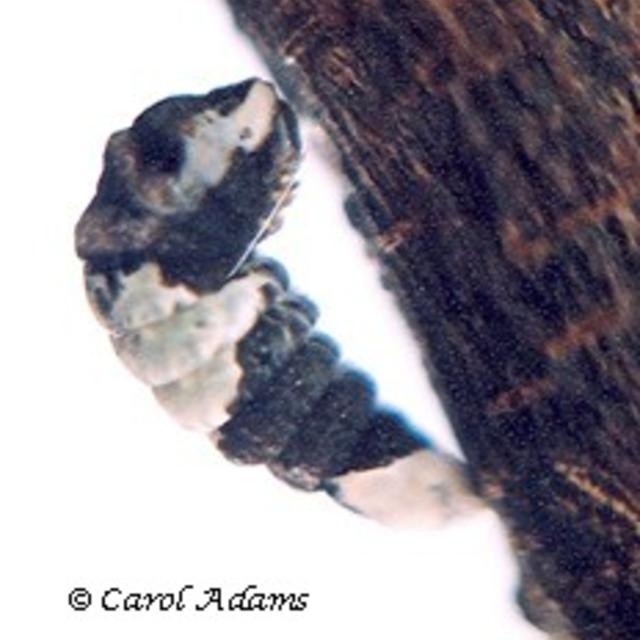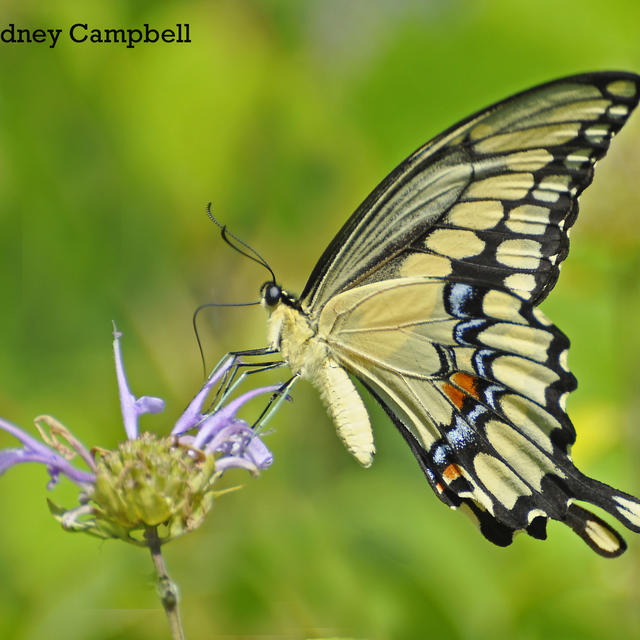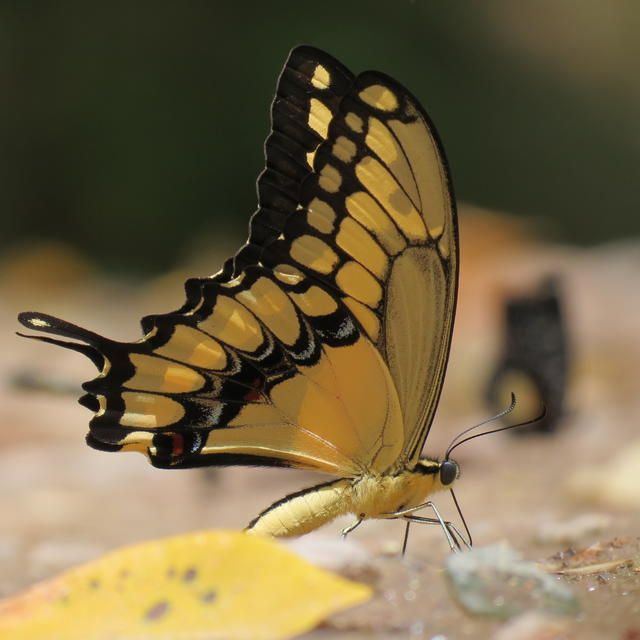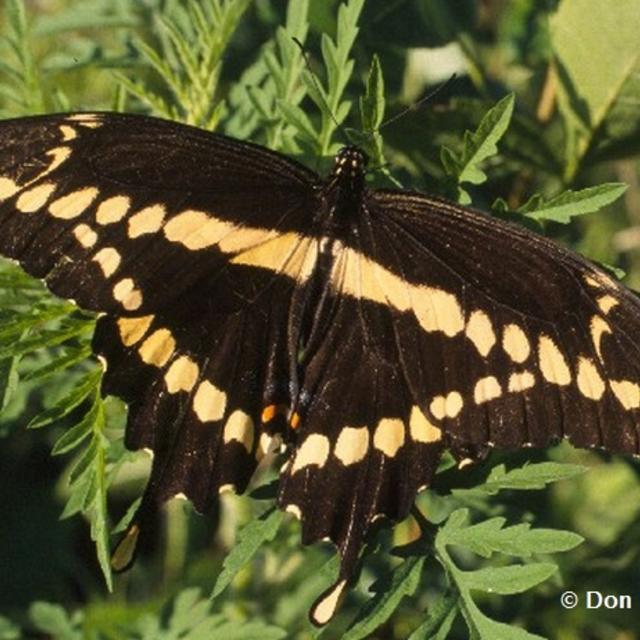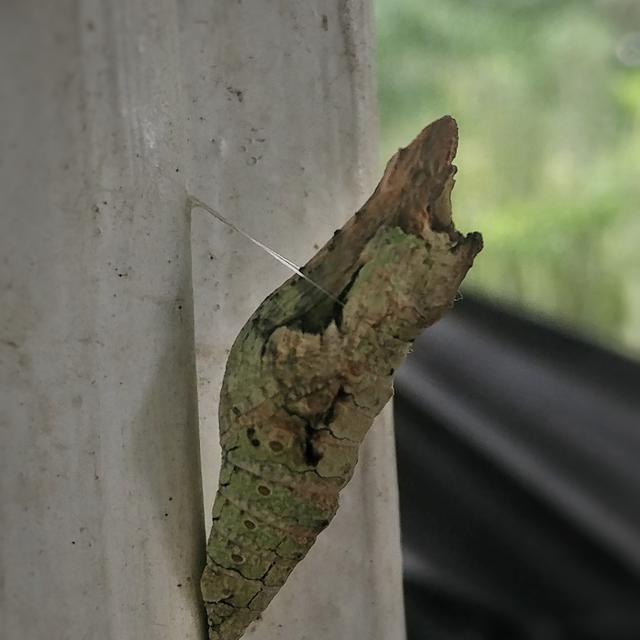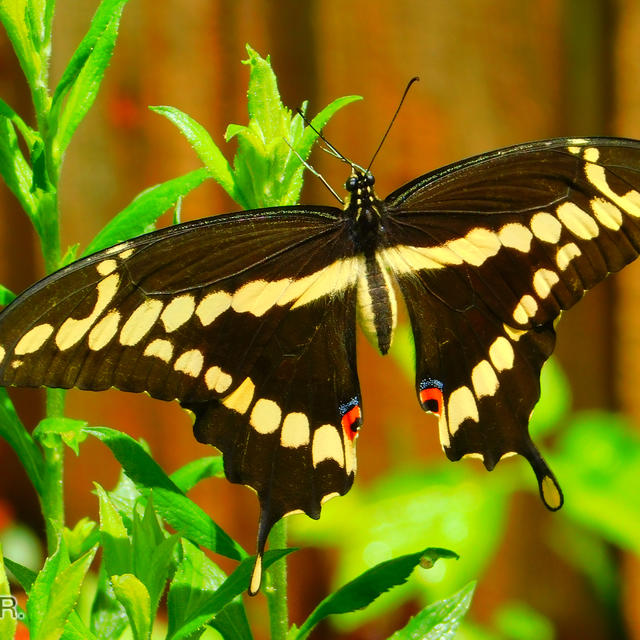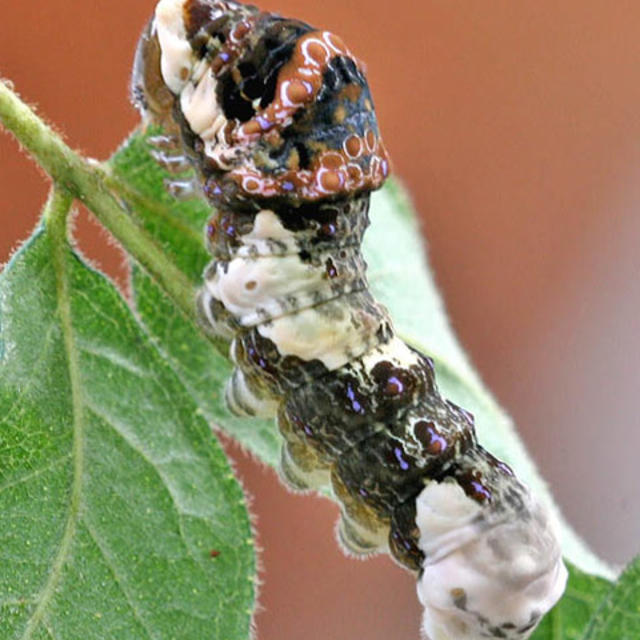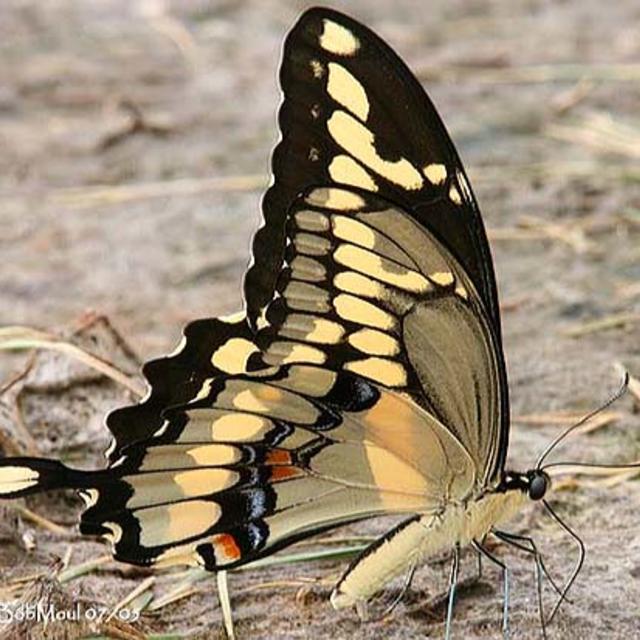Giant Swallowtail
Papilio cresphontes Cramer, 1777
Family: Papilionidae
Subfamily: Papilioninae
Identification: Forewing with diagonal band of yellow spots. Tails are edged with black and filled with yellow.
Wing Span: 4 - 6 1/4 inches (10.2 - 16 cm).
Life History: Males patrol for receptive females. Females lay single eggs on host leaves and twigs. Caterpillars resemble bird droppings and eat leaves and young shoots. Chrysalids hibernate.
Flight: Two in the north from May-September; all year in Florida and the Deep South.
Caterpillar Hosts: Trees and herbs of the citrus family (Rutaceae) including Citrus species, prickly ash (Zanthoxylum americanum), hop tree (Ptelea trifoliata), and Common Rue (Ruta graveolens).
Adult Food: Nectar from lantana, azalea, bougainvilla, bouncing Bet, dame's rocket, goldenrod, Japanese honeysuckle, and swamp milkweed.
Habitat: Many locales including rocky and sandy hillsides near streams or gullies in the north; pine flats, towns, and citrus groves in the south.
Range: Throughout eastern North America west to the Rocky Mountains, south through the desert Southwest to South America. A rare stray to Quebec, North Dakota, and Bermuda.
Conservation: Not required in the United States.
NCGR: G5 - Demonstrably secure globally, though it may be quite rare in parts of its range, especially at the periphery.
Management Needs: Caterpillars ("orange dogs") are occasional pests of citrus.
Get your BAMONA Gear!
Please donate!
We depend on donations to keep Butterflies and Moths of North America freely available. We want to express our gratitude to all who showed their support by making a contribution this year. You can donate to support this project at any time.
Advertise with us!
Do you have a product or service that you think would interest BAMONA users? If you would like to advertise on this website, contact us by email, or use the contact form and select the "Advertising" category.
Verified Sightings
Displaying 1 - 24 of 3285 verified sightings

Observation date: Sep 08, 2024
Submitted by: BarbSendelbach
Region: Sussex County, New Jersey, United States
Verified by: BarbSendelbach
Verified date: Mar 10, 2025

Observation date: Jul 23, 2024
Submitted by: michbirder
Region: Midland County, Michigan, United States
Verified by: elsner
Verified date: Feb 27, 2025

Observation date: Jul 25, 2024
Submitted by: nc1marm
Region: St. Clair County, Michigan, United States
Verified by: elsner
Verified date: Feb 27, 2025

Observation date: Jun 06, 2024
Submitted by: Leewida
Region: Montcalm County, Michigan, United States
Verified by: elsner
Verified date: Feb 27, 2025

Observation date: Jun 11, 2024
Submitted by: John429
Region: Jackson County, Michigan, United States
Verified by: elsner
Verified date: Feb 27, 2025

Observation date: Feb 23, 2025
Submitted by: John Gibbons
Region: Pinellas County, Florida, United States
Verified by: John Calhoun
Verified date: Feb 25, 2025

Observation date: Jun 20, 2021
Submitted by: Bberrio
Region: Morris County, New Jersey, United States
Verified by: jwileyrains
Verified date: Jan 02, 2025

Observation date: Aug 16, 2024
Submitted by: PNAT24
Region: Pike County, Pennsylvania, United States
Verified by: davidwright
Verified date: Dec 22, 2024

Observation date: Oct 04, 2024
Submitted by: jrmbutterfly
Region: Pima County, Arizona, United States
Verified by: jwileyrains
Verified date: Dec 05, 2024

Observation date: Aug 22, 2019
Submitted by: Donna Caporale
Region: Ocean County, New Jersey, United States
Verified by: jwileyrains
Verified date: Nov 17, 2024

Observation date: Aug 22, 2024
Submitted by: Blond crestedwarbler
Region: Mercer County, New Jersey, United States
Verified by: jwileyrains
Verified date: Nov 11, 2024

Observation date: Nov 09, 2024
Submitted by: therapypetz
Region: Broward County, Florida, United States
Verified by: curtis.lehman
Verified date: Nov 09, 2024

Observation date: Nov 01, 2024
Submitted by: marilynne
Region: Palm Beach County, Florida, United States
Verified by: John Calhoun
Verified date: Nov 06, 2024

Observation date: Apr 22, 2014
Submitted by: Sheilabean
Region: Texas, Tarrant County, United States
Verified by: jwileyrains
Verified date: Oct 18, 2024

Observation date: Aug 25, 2024
Submitted by: Mike L
Region: Erie County, Pennsylvania, United States
Verified by: davidwright
Verified date: Oct 14, 2024

Observation date: Sep 30, 2024
Submitted by: bentert
Region: Pima County, Arizona, United States
Verified by: John Saba
Verified date: Oct 09, 2024

Observation date: Sep 23, 2024
Submitted by: COA1955
Region: Morgan County, Colorado, United States
Verified by: mikefisher
Verified date: Oct 07, 2024

Observation date: Sep 03, 2024
Submitted by: GLG
Region: Walton County, Florida, United States
Verified by: John Calhoun
Verified date: Oct 03, 2024

Observation date: Oct 03, 2024
Submitted by: therapypetz
Region: Broward County, Florida, United States
Verified by: John Calhoun
Verified date: Oct 03, 2024

Observation date: Sep 03, 2024
Submitted by: COA1955
Region: Morgan County, Colorado, United States
Verified by: mikefisher
Verified date: Sep 15, 2024

Observation date: Aug 25, 2024
Submitted by: Jeannine Izzarelli
Region: Windham County, Connecticut, United States
Verified by: jwileyrains
Verified date: Sep 14, 2024

Observation date: Aug 23, 2024
Submitted by: COA1955
Region: Morgan County, Colorado, United States
Verified by: mikefisher
Verified date: Sep 13, 2024

Observation date: Aug 27, 2024
Submitted by: Kentonky41015
Region: Kenton County, Kentucky, United States
Verified by: CA Ivy
Verified date: Aug 29, 2024

Observation date: Aug 24, 2024
Submitted by: ebea
Region: Davidson County, Tennessee, United States
Verified by: James Steen
Verified date: Aug 24, 2024
- 1 of 137
- next ›


